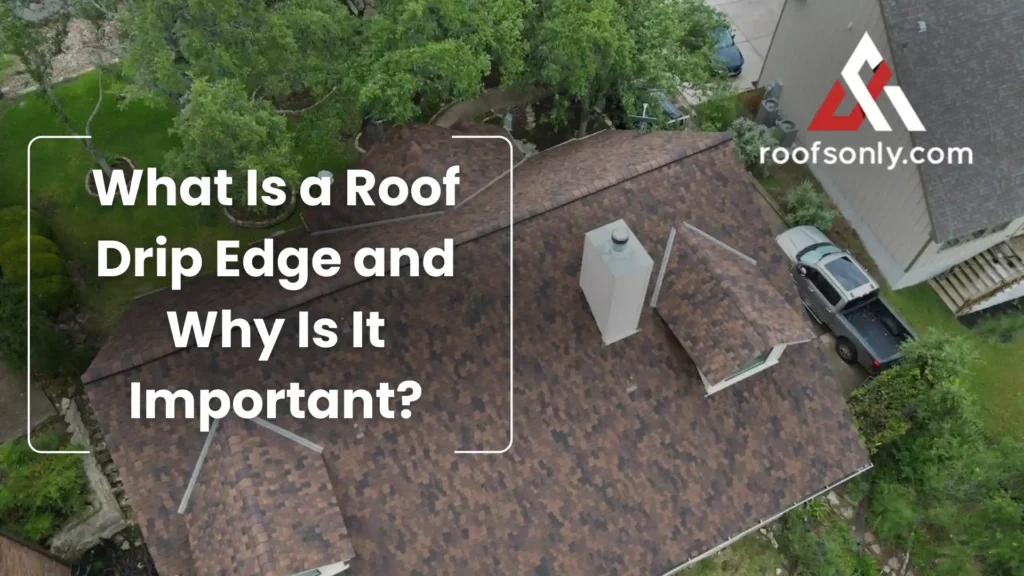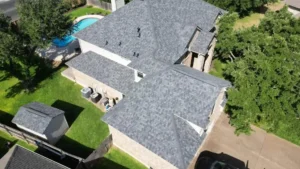Posted on Sunday, February 18th, 2024 at 7:40 pm

A roof drip edge is a metal or vinyl strip installed along the edges of a roof to divert water away from the underlying structure. It directs rainwater into the gutters, preventing it from getting underneath the shingles and causing rot or mold in the roof deck and fascia. It also protects the roof’s edges from wind-driven rain, ensuring the materials stay dry and intact. By guiding water away from the home, a drip edge plays a key role in maintaining the integrity and longevity of the entire roofing system.
Roof Water Damage Prevention
Protecting your roof from water damage is a critical aspect of home maintenance, especially in areas like Texas that are prone to heavy rain and hail. When a roof lacks adequate protection, water can wreak havoc in several ways. It can seep under shingles, leading to rot in the wooden parts of the roof structure. Over time, this rot can compromise the roof’s integrity, making it unsafe.
Water intrusion also paves the way for mold and mildew growth inside your home. This can damage your property and pose serious health risks to inhabitants by affecting the air quality. Furthermore, without proper water diversion, rainwater can accumulate around your home’s foundation. This accumulation increases the risk of flooding and can weaken the foundation, threatening the stability of your house.
Uncontrolled water flow off the roof can also erode the landscaping around your home, leading to additional maintenance issues and expenses. Additionally, persistent moisture on certain roof parts can cause shingles to deteriorate faster than they normally would, leading to leaks and necessitating premature roof repairs or replacement.
Purpose of Roof Drip Edges
Roof drip edges are simple components that can make a big difference in protecting your home. For instance, they can:
- Guide Water Away: Roof drip edges redirect rainwater away from your roof and into the gutters. This prevents water from slipping under the shingles, protecting the wooden parts of your roof from swelling or rotting.
- Prevent Water Damage: By guiding water into the gutters, drip edges prevent it from pooling on your roof or running down the sides of your house. This reduces the risk of leaks, mold growth, and structural damage to your home.
- Protect the Foundation: Drip edges play a key role in keeping water away from your home’s foundation. By ensuring water flows into the gutters, they prevent flooding and erosion.
- Extend Roof Life: By preventing water from seeping under shingles, drip edges prolong the life of your roof. This means fewer repairs and a longer time between roof replacements.
Installing a Roof Drip Edge
Installing a roof drip edge is an excellent way of maintaining your home’s roof and overall structure. Here’s how you can determine whether your home might need a roof drip edge:
- Look for Signs of Water Damage: If you notice water stains on your siding or along the fascia boards, it might be time to consider installing a drip edge. These signs indicate that water is not properly flowing away from your roof.
- Check During Roof Inspection or Replacement: If you’re getting your roof inspected or replaced, ask the inspector or contractor about the condition of your roof or drip edge. It’s the perfect time to add or replace a drip edge if necessary.
- Observe Water Flow During Rain: Watch how water flows off your roof during a storm. A drip edge might be necessary if water is spilling over the sides rather than going into the gutters.
Enhancing Roof Drainage
Enhancing your roof’s drainage system is key to protecting your home from water damage. In addition to installing a drip edge, you can improve your roof drainage by:
- Keeping Gutters Clean: Regularly remove leaves and debris from your gutters. Clogged gutters can cause water to overflow and damage your roof and foundation.
- Installing Gutter Guards: Gutter guards prevent debris from blocking your gutters, keeping water flowing away from your roof efficiently.
- Ensuring Proper Gutter Placement: Make sure your gutters are close enough to catch water coming off the roof. Water can slip through and cause damage if they’re too far away.
- Checking Downspouts for Blockages: Ensure all downspouts are clear and direct water away from your home. Blocked downspouts can lead to water backing up and causing problems.
- Inspecting and Repairing Seals and Flashing: Routinely check the seals and flashing around vents, chimneys, and roof edges. Leaks in these areas can compromise your roof’s drainage.
- Arranging Regular Roof Inspections: Have a professional inspect your roof regularly. Early detection and repair can prevent minor issues from becoming major drainage problems.
Drip Edge Material Types
 Choosing the right material for your roof drip edge is important for both performance and aesthetics. Drip edges come in a variety of materials that offer different benefits, from durability and corrosion resistance to aesthetic appeal. Here’s a look at some common types:
Choosing the right material for your roof drip edge is important for both performance and aesthetics. Drip edges come in a variety of materials that offer different benefits, from durability and corrosion resistance to aesthetic appeal. Here’s a look at some common types:
- Aluminum: Aluminum drip edges are lightweight and corrosion-resistant, making them a popular choice for many homeowners. They work well in most climates and are available in a variety of colors to match your roof or gutters.
- Galvanized Steel: Galvanized steel drip edges offer great strength and durability. They’re coated with a layer of zinc to prevent rust, making them ideal for areas with harsh weather conditions. However, they can be heavier than aluminum and often require professional installation.
- Copper: Copper drip edges add a touch of elegance to any roof with their distinctive look that ages to a beautiful patina over time. While more expensive, copper is extremely durable and resistant to corrosion, appealing to homeowners looking for a long-term solution with character.
- Vinyl: Vinyl drip edges are a cost-effective and flexible option. They resist corrosion, making them suitable for wet climates, but are not as durable as metal options over the long term. Vinyl is lightweight and easy to install, which can be a significant advantage for DIY projects.
Talk to the Roofing Professionals at RoofsOnly.com
A professional from RoofsOnly.com can provide a comprehensive evaluation of your roof’s condition and determine whether you need a drip edge installation or replacement. We can also take care of the installation or replacement for you. Our expert service is backed by a 100% satisfaction guarantee that your roof will have the best possible protection and performance. Contact us now to arrange a free roof inspection.
Related Reading:

